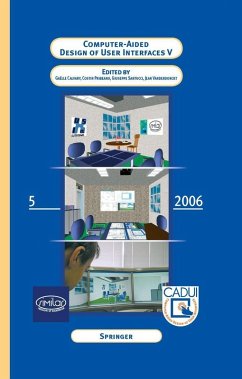Computer-Aided Design of User Interfaces V (eBook, PDF)
Proceedings of the Sixth International Conference on Computer-Aided Design of User Interfaces CADUI '06 (6-8 June 2006, Bucharest, Romania)
Redaktion: Calvary, Gaëlle; Vanderdonckt, Jean; Santucci, Giuseppe; Pribeanu, Costin
73,95 €
73,95 €
inkl. MwSt.
Sofort per Download lieferbar

37 °P sammeln
73,95 €
Als Download kaufen

73,95 €
inkl. MwSt.
Sofort per Download lieferbar

37 °P sammeln
Jetzt verschenken
Alle Infos zum eBook verschenken
73,95 €
inkl. MwSt.
Sofort per Download lieferbar
Alle Infos zum eBook verschenken

37 °P sammeln
Computer-Aided Design of User Interfaces V (eBook, PDF)
Proceedings of the Sixth International Conference on Computer-Aided Design of User Interfaces CADUI '06 (6-8 June 2006, Bucharest, Romania)
Redaktion: Calvary, Gaëlle; Vanderdonckt, Jean; Santucci, Giuseppe; Pribeanu, Costin
- Format: PDF
- Merkliste
- Auf die Merkliste
- Bewerten Bewerten
- Teilen
- Produkt teilen
- Produkterinnerung
- Produkterinnerung

Bitte loggen Sie sich zunächst in Ihr Kundenkonto ein oder registrieren Sie sich bei
bücher.de, um das eBook-Abo tolino select nutzen zu können.
Hier können Sie sich einloggen
Hier können Sie sich einloggen
Sie sind bereits eingeloggt. Klicken Sie auf 2. tolino select Abo, um fortzufahren.

Bitte loggen Sie sich zunächst in Ihr Kundenkonto ein oder registrieren Sie sich bei bücher.de, um das eBook-Abo tolino select nutzen zu können.
This book gathers the latest experience of experts, research teams and leading organizations involved in computer-aided design of user interfaces of interactive applications. This area investigates how it is desirable and possible to support, to facilitate and to speed up the development life cycle of any interactive system. In particular, it stresses how the design activity could be better understood for different types of advanced interactive systems.
- Geräte: PC
- ohne Kopierschutz
- eBook Hilfe
- Größe: 140.66MB
Andere Kunden interessierten sich auch für
![Task Models and Diagrams for User Interface Design (eBook, PDF) Task Models and Diagrams for User Interface Design (eBook, PDF)]() Task Models and Diagrams for User Interface Design (eBook, PDF)40,95 €
Task Models and Diagrams for User Interface Design (eBook, PDF)40,95 €![Human Interface and the Management of Information. Methods, Techniques and Tools in Information Design (eBook, PDF) Human Interface and the Management of Information. Methods, Techniques and Tools in Information Design (eBook, PDF)]() Human Interface and the Management of Information. Methods, Techniques and Tools in Information Design (eBook, PDF)113,95 €
Human Interface and the Management of Information. Methods, Techniques and Tools in Information Design (eBook, PDF)113,95 €- -55%11
![Linux-Unix-Kurzreferenz (eBook, PDF) Linux-Unix-Kurzreferenz (eBook, PDF)]() Christine WolfingerLinux-Unix-Kurzreferenz (eBook, PDF)8,98 €
Christine WolfingerLinux-Unix-Kurzreferenz (eBook, PDF)8,98 € - -48%11
![Leistungsbewertung bei Computersystemen (eBook, PDF) Leistungsbewertung bei Computersystemen (eBook, PDF)]() Hans Günther KruseLeistungsbewertung bei Computersystemen (eBook, PDF)20,67 €
Hans Günther KruseLeistungsbewertung bei Computersystemen (eBook, PDF)20,67 € - -22%11
![Betriebssysteme (eBook, PDF) Betriebssysteme (eBook, PDF)]() Rüdiger BrauseBetriebssysteme (eBook, PDF)42,99 €
Rüdiger BrauseBetriebssysteme (eBook, PDF)42,99 € ![Web Component Development with Zope 3 (eBook, PDF) Web Component Development with Zope 3 (eBook, PDF)]() Philipp WeitershausenWeb Component Development with Zope 3 (eBook, PDF)40,95 €
Philipp WeitershausenWeb Component Development with Zope 3 (eBook, PDF)40,95 €- -20%11
![Linux (eBook, PDF) Linux (eBook, PDF)]() Jürgen GulbinsLinux (eBook, PDF)59,99 €
Jürgen GulbinsLinux (eBook, PDF)59,99 € -
-
-
This book gathers the latest experience of experts, research teams and leading organizations involved in computer-aided design of user interfaces of interactive applications. This area investigates how it is desirable and possible to support, to facilitate and to speed up the development life cycle of any interactive system. In particular, it stresses how the design activity could be better understood for different types of advanced interactive systems.
Dieser Download kann aus rechtlichen Gründen nur mit Rechnungsadresse in A, B, BG, CY, CZ, D, DK, EW, E, FIN, F, GR, HR, H, IRL, I, LT, L, LR, M, NL, PL, P, R, S, SLO, SK ausgeliefert werden.
Produktdetails
- Produktdetails
- Verlag: Springer Netherlands
- Seitenzahl: 298
- Erscheinungstermin: 5. Oktober 2007
- Englisch
- ISBN-13: 9781402058202
- Artikelnr.: 37354764
- Verlag: Springer Netherlands
- Seitenzahl: 298
- Erscheinungstermin: 5. Oktober 2007
- Englisch
- ISBN-13: 9781402058202
- Artikelnr.: 37354764
- Herstellerkennzeichnung Die Herstellerinformationen sind derzeit nicht verfügbar.
Gaëlle Calvary, University of Grenoble, France / Costin Pribeanu, National Institute of Research and Development in Informatics, Bucharest, Romania / Giuseppe Santucci, Università di Roma "La Sapienza", Italia / Jean Vanderdonckt, Université Catholique de Louvain, Louvain-la-Neuve, Belgium
Generating User Interfaces from Conceptual Models: A Model-Transformation Based Approach.- Towards Object Oriented, Uiml-Based Interface Descriptions for Mobile Devices.- Towards A System of Patterns for the Design of Multimodal Interfaces.- Design Options for Multimodal Web Applications.- A Generic Approach for Pen-Based User Interface Development.- Participatory Design Meets Mixed Reality Design Models.- A Method for Developing 3D User Interfaces of Information Systems.- GestAction3D: A Platform for Studying Displacements and Deformations of 3D Objects Using Hands.- Designing and Developing Multi-User, Multi-Device Web Interfaces.- A System to Support Publishing, Editing, and Creating Web Content for Various Devices.- Transformational Consistency.- Rapid Prototyping of Distributed User Interfaces.- The Comets Inspector.- A Generic Approach for Multi-Device User Interface Rendering with UIML.- Device Independent Layout and Style Editing Using Multi-Level Style Sheets.- Automatic Interface Generation Through Interaction, Users, and Devices Modeling.- The Meta Sketch Editor.- A Hybrid Tool for User Interface Modeling and Prototyping.- Towards A Support of User Interface Design By Composition Rules.- IdealXML: An Interaction Design Tool.- Integrating Model-Based and Task-Based Approaches to User Interface Generation.- Automated Repair Tool for Usability and Accessibility of Web Sites.- Automating Guidelines Inspection.- Remote Web Usability Evaluation Exploiting Multimodal Information on User Behavior.
Generating User Interfaces from Conceptual Models: A Model-Transformation Based Approach.- Towards Object Oriented, Uiml-Based Interface Descriptions for Mobile Devices.- Towards A System of Patterns for the Design of Multimodal Interfaces.- Design Options for Multimodal Web Applications.- A Generic Approach for Pen-Based User Interface Development.- Participatory Design Meets Mixed Reality Design Models.- A Method for Developing 3D User Interfaces of Information Systems.- GestAction3D: A Platform for Studying Displacements and Deformations of 3D Objects Using Hands.- Designing and Developing Multi-User, Multi-Device Web Interfaces.- A System to Support Publishing, Editing, and Creating Web Content for Various Devices.- Transformational Consistency.- Rapid Prototyping of Distributed User Interfaces.- The Comets Inspector.- A Generic Approach for Multi-Device User Interface Rendering with UIML.- Device Independent Layout and Style Editing Using Multi-Level Style Sheets.- Automatic Interface Generation Through Interaction, Users, and Devices Modeling.- The Meta Sketch Editor.- A Hybrid Tool for User Interface Modeling and Prototyping.- Towards A Support of User Interface Design By Composition Rules.- IdealXML: An Interaction Design Tool.- Integrating Model-Based and Task-Based Approaches to User Interface Generation.- Automated Repair Tool for Usability and Accessibility of Web Sites.- Automating Guidelines Inspection.- Remote Web Usability Evaluation Exploiting Multimodal Information on User Behavior.







